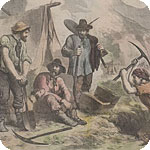The Enoch Pratt Free Library, a public library in Baltimore, Maryland, has a number of great digital collections available. While a few have materials related to the Civil War era, one particularly interesting collection is of broadsides published during the 19th century. Over 100 broadsides are available, including a number from the Civil War. As Maryland was a border state, the collection contains broadsides from both Union and Confederate supporters. Not all of these broadsides are related to politics. Other topics include love songs and temperance songs.
7
Dec
09
Nineteenth Century Broadside Collection
Posted by sailerd Published in 19th Century (1840-1880), Images, Letters & Diaries Themes: Education & Culture30
Nov
09
American Song Sheets
Posted by Published in 19th Century (1840-1880), Images, Letters & Diaries Themes: Education & Culture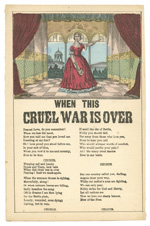
The Duke University libraries have several digital collections available on their websites. One of these is the American Song Sheets collection, which contains around 1800 song sheets, all from the 19th century. It was customary during the 19th century for publishers to print just the lyrics of popular songs on a single sheet, usually illustrated with a drawing. These became known as song sheets, handbills, or broadsides. The illustrations and the lyrics to these songs provide an insight into popular themes of the time. The collection contains a lot of broadsides from the South and the Civil War era in particular, so it can be useful for understanding homefront morale during the war or for studying the larger context of the 19th century. There are two options for searching the collection: by keyword on the main page or by using the index that allows the user to search the text of the song lyrics. For those interested in the music to accompany the words, there is also a searchable database of sheet music.
24
Nov
09
Picturing America: Viewing the Civil War Through Art
Posted by Published in Civil War (1861-1865), Images, Lesson Plans Themes: Education & Culture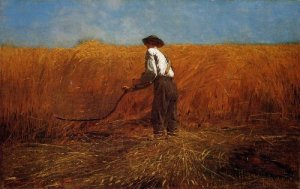
Picturing America, in an initiative funded by the National Endowment for the Humanities, brings examples from the many different genres of American art into the classroom. The program provides new and interesting pathways for students to understand American history. In addition to the resource book, the website also offers several additional resources for teachers looking to incorporate the program into their lesson plans.
One of the lesson plans available, “Homer’s Civil War Veteran: Battlefield to Wheat Field,” draws on both visual and written primary sources. Aimed at those in middle school (grades six through eight), the first activity has students compare and contrast Winslow Homer’s painting, The Veteran in a New Field, with Timothy O’Sullivan’s photograph, A Harvest of Death, Gettysburg 1863. The second has students read a selection from Civil War Captain James Wren’s diary concerning his experience at the Second Battle of Bull Run/Battle of Second Manassas. Finally, the third encourages students to make connections between all three activities, asking what the anonymous veteran in Homer’s painting might be thinking and why. The activities are easily adaptable to individual classroom needs and are creative enough to capture students’ interests.
23
Nov
09
Transatlantic Telegraph
Posted by sailerd Published in Antebellum (1840-1861), Historic Periodicals, Images Themes: Business & Industry, Science & Technology, US & the World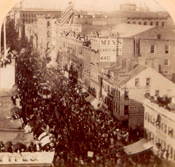 This section of the “History of the Atlantic Cable & Undersea Communications” website is a great resource on the first transatlantic cable in 1858. The site offers lots of information, but the best are the transcripts and images from publications such as Frank Leslie’s Illustrated Newspaper. Newspapers provided readers in 1858 with detailed accounts on the progress of the cable’s construction and the celebrations that took place in cities after the first official message was sent. “Wherever the news penetrated there was a public jubilee” and, according to the Illustrated London News, “the most thorough and systematic display of popular joy took place” in New York City. While the cable stopped working after only a few days, it marked an important first step.
This section of the “History of the Atlantic Cable & Undersea Communications” website is a great resource on the first transatlantic cable in 1858. The site offers lots of information, but the best are the transcripts and images from publications such as Frank Leslie’s Illustrated Newspaper. Newspapers provided readers in 1858 with detailed accounts on the progress of the cable’s construction and the celebrations that took place in cities after the first official message was sent. “Wherever the news penetrated there was a public jubilee” and, according to the Illustrated London News, “the most thorough and systematic display of popular joy took place” in New York City. While the cable stopped working after only a few days, it marked an important first step.
20
Nov
09
Mitchell's New Universal Atlas, 1857
Posted by sailerd Published in 19th Century (1840-1880), Images, Maps Themes: US & the World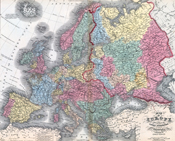
While my last post was on House Divided’s “zoomable” maps , we also have almost all of the maps from Mitchell’s 1857 atlas available. This includes all the US states and territories as well as countries and major cities from around the world. For example, check out the maps of Africa, Asia, Australia, the Carribean, Europe, England, Jerusalem, London, the Middle East, and South America. These maps can help students see how those in the 19th century saw the world that they lived in.
10
Nov
09
Hearts at Home
Posted by Published in 19th Century (1840-1880), Images, Letters & Diaries Themes: Women & Families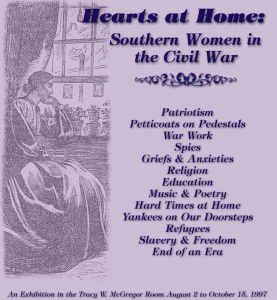
The University of Virginia Library has an old exhibit on Southern women in the Civil War that is still accessible online. This exhibit is very well organized into categories that represent major concerns that occupied women on the home front before, during, and after the war. Under each category, the narrative is presented using a variety of primary sources. Most of the sources are letters and diaries, which are summarized using important excerpts. Some sections also make use of photographs or popular cards of the time. The originals of all of the primary sources are available as a scanned image on the website. The format of the exhibit is straight-forward and easy to understand, and it tells the story of women during this time period in a concise and very effective way. It would be easy for teachers to present one or more of these topics to a classroom using the primary documents selected here as a resource.
10
Nov
09
Photography Bringing War Reporting to Life
Posted by Published in Civil War (1861-1865), Images, Lesson Plans Themes: Education & Culture “The Matthew Brady Bunch: Civil War Newspapers” is a series of lesson activities that ultimately has students produce their own newspaper articles on different aspects of the Civil War as a larger class project. Created by Amy Donnelly and Elizabeth Ridgway for American Memory, the project is intended for students in the seventh grade, though it can easily be adapted. The activities require students to use a selection of the Library of Congress’ collection of Civil War photographs, first to analyze the primary sources before choosing one for their article. Eventually the goal is for students to produce a website, or an online archive, for their “newspaper”.
“The Matthew Brady Bunch: Civil War Newspapers” is a series of lesson activities that ultimately has students produce their own newspaper articles on different aspects of the Civil War as a larger class project. Created by Amy Donnelly and Elizabeth Ridgway for American Memory, the project is intended for students in the seventh grade, though it can easily be adapted. The activities require students to use a selection of the Library of Congress’ collection of Civil War photographs, first to analyze the primary sources before choosing one for their article. Eventually the goal is for students to produce a website, or an online archive, for their “newspaper”.
Meant to take place over several days (possibly a week), the project can be modified to suit individual class needs. One example of such a modification would make the project interdisciplinary, in conjunction with English class. The “Matthew Brady Bunch” project acts as a good way to end a unit on the Civil War, allowing a class to cover a wide range of events, people, or places. In addition, the project requires students to work with primary sources, develop research skills, and improve writing skills.
9
Nov
09
California Gold Rush
Posted by sailerd Published in Antebellum (1840-1861), Images, Lesson Plans Themes: Settlers & ImmigrantsThe University of California’s Calisphere has several “themed collections” on a number of subjects, including the Gold Rush, that are designed to help educators “quickly find compelling primary sources.” One can use this site to explore how California “changed…dramatically” as a result of the “sudden influx” of people after 1848. The collection is sub-divided into several topics, such as “Environmental Impact” and “Everyday Life and People.” Each one provides a short overview and lots of relevant primary sources. In addition, the collection has links to primary sources related to the Gold Rush – Frontier and pioneer life, western expansion, and more. Also check out the teacher resources, which offer ideas for using primary sources in the classroom.
4
Nov
09
Digital History – Edward Ayers
Posted by sailerd Published in 19th Century (1840-1880), Images, Maps Themes: US & the World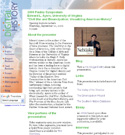
The history department at the University of Nebraska has a number of lectures on digital history projects available, including Edward Ayers’ “Civil War and Emancipation: Visualizing American History.” Ayers, who developed the Valley of the Shadow, discusses that project as well as the Emancipation Project and the Southern History Database. While a transcript is not available, Ayers also presents his ideas in a short essay, “Mapping Freedom.” Digital history projects like the Valley of the Shadow allow historians to “bore down to the stories of individual people and families and, as Ayers explains, in this case “see how people held in bondage created new lives for themselves.” Also be sure to check out the interviews with other historians who share their thoughts on digital history.
3
Nov
09
Filibustering
Posted by sailerd Published in Antebellum (1840-1861), Historic Periodicals, Images Themes: US & the World
Most students are unfamiliar with the Filibuster of the 1850s. If anything, one associates it with attempts to prevent a vote on bills in the US Senate. T. J. Stiles’ essay in the Gilder Lehrman’s online journal History Now provides a nice overview of the subject and profiles the infamous “Filibuster King” William Walker. “Filibusters were independent adventurers who launched freelance invasions of foreign countries” and most planned “to annex them to the United States,” as Stiles explains. Walker’s actions violated the US Neutrality Act, but he always believed that he was “destined to create a central American empire.” One of Walker’s targets was Nicaragua, which he invaded in 1855 and was later forced out by May 1857. While Stiles discusses this invasion, another short essay provides images from Frank Leslie’s Illustrated Newspaper. House Divided also has material on this topic, including more primary sources related to Walker and other filibusters like John A. Quitman.

